Supper at Emmaus is an event in the Gospel of Luke.

Frederik Johannes "Frits" Lugt, was a self-taught collector and connoisseur of Dutch drawings and prints and a selfless and tireless compiler of essential reference tools documenting Northern European prints and drawings, collectors' stamps and sale catalogues. An authority on Rembrandt's drawings, he collected all of the known etchings made by Rembrandt during his career.

The Soviet sale of Hermitage paintings in 1930 and 1931 resulted in the departure of some of the most valuable paintings from the collection of the State Hermitage Museum in Leningrad to Western museums. Several of the paintings had been in the Hermitage Collection since its creation by Empress Catherine the Great. About 250 paintings were sold, including masterpieces by Jan van Eyck, Titian, Rembrandt, Rubens, Raphael, and other important artists. Andrew Mellon donated the twenty-one paintings he purchased from the Hermitage to the United States government in 1937, which became the nucleus of the National Gallery of Art in Washington, D.C.

Self-Portrait is a 1660 oil on canvas painting by the Dutch artist Rembrandt, one of over 40 self-portraits by Rembrandt. Painted when the artist was fifty-four, it has been noted as a work in which may be seen "the wrinkled brow and the worried expression the troubled condition of his mind". Part of the Benjamin Altman Collection, it has been in the Metropolitan Museum of Art since 1913.
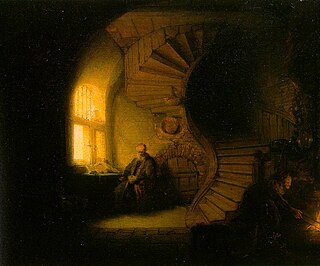
Philosopher in Meditation, recently renamed Philosopher in Contemplation by the museum, is the traditional title of an oil painting in the Musée du Louvre, Paris, that is attributed to the 17th-century Dutch artist Rembrandt.

Old Man with a Gold Chain is a portrait by Rembrandt, painted around 1631 and now in the Art Institute of Chicago.

The Head of Christ is a 1648 oil-on-panel painting by the Dutch artist Rembrandt. It is now in the Gemäldegalerie in Berlin.

Portrait of a Man with Arms Akimbo, formerly known as Portrait of a Foreign Admiral or Portrait of a Dutch Admiral, is an oil painting portrait by Rembrandt signed and dated 1658. It is now in the collection of the Agnes Etherington Art Centre at Queen's University in Kingston, Ontario, and measures 107.4 cm by 87.0 cm.
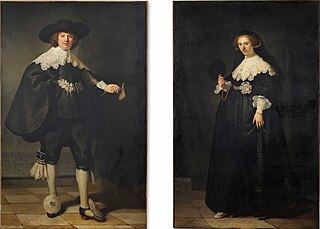
The pendant portraits of Maerten Soolmans and Oopjen Coppit are a pair of full-length wedding portraits by Rembrandt. They were painted on the occasion of the marriage of Maerten Soolmans and Oopjen Coppit in 1634. Formerly owned by the Rothschild family, they became jointly owned by the Louvre Museum and the Rijksmuseum in 2015 after both museums managed to contribute half of the purchase price of €160 million, a record for works by Rembrandt.
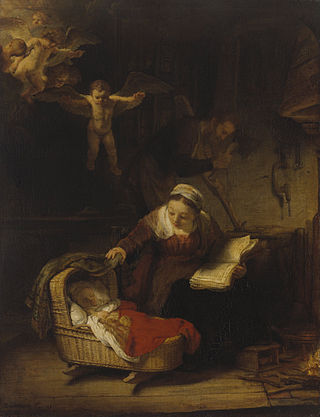
The Holy Family with Angels (1645) is an oil painting on canvas by the Dutch painter Rembrandt. It is an example of Dutch Golden Age painting and is now in the collection of the Hermitage Museum.

The Kitchen Maid (1651) is an oil-on-canvas painting by the Dutch painter Rembrandt. It is an example of Dutch Golden Age painting and is now in the collection of the Nationalmuseum, Stockholm, Sweden.

The Stone Bridge is a 1637 landscape painting by the Dutch Golden Age painter Rembrandt in the collection of the Rijksmuseum.
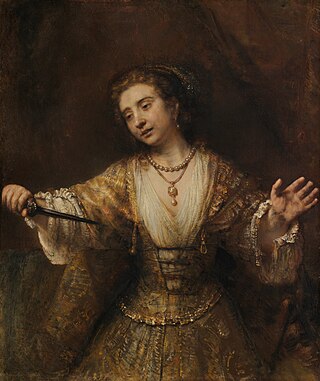
Lucretia is a 1664 history painting of Roman noblewoman Lucretia, historically attributed to the Dutch Golden Age painter Rembrandt in the collection of the National Gallery of Art. In 2015, Ernst van de Wetering of the Rembrandt Research Project said that "the formal properties and execution of [this] painting, I am convinced, exclude the possibility that it could be an autograph work by Rembrandt", and that the painting recalls Aert de Gelder. The painting is not included in the project's 2015 Rembrandt corpus.
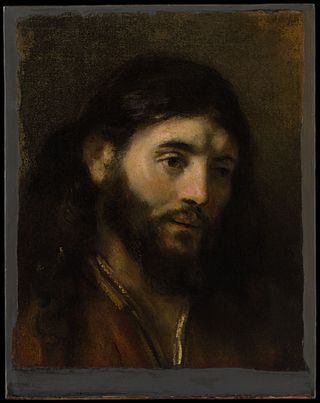
Head of Christ is a 1650s painting by Rembrandt's workshop. It shows Christ with a beard and long dark hair. It is in the collection of the Metropolitan Museum of Art.

Oval Portrait of a Woman is a 1633 portrait painting painted by Rembrandt. It shows a woman with a millstone collar and diadem cap. It is in the collection of the Metropolitan Museum of Art.

Portrait of Petronella Buys (1610–1670) is a 1635 portrait painting painted by Rembrandt. It shows a young woman with a very large and impressive millstone collar. It is in a private collection.
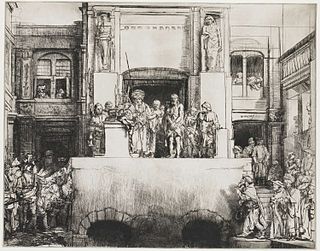
Christ Presented to the People, also known as Ostentatio Christi or Ecce Homo, is a drypoint print by Rembrandt van Rijn which exists in eight states, all c.1655. It is one of the two largest prints made by Rembrandt, about 15 by 18 inches, similar to his 1653 engraving of The Three Crosses. It has been described by Christie's as "at the summit of the western printmaking tradition".
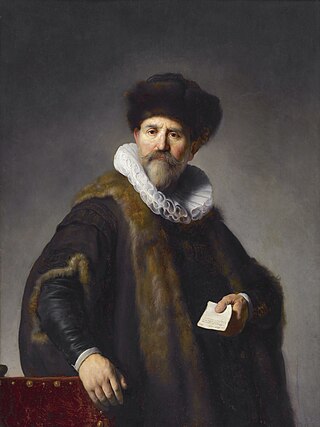
Portrait of Nicolaes Ruts (1573–1638) is a 1631 painting by the Dutch artist Rembrandt van Rijn. It is one of Rembrandt's earliest commissioned pieces and helped launch his career as a portrait painter. The painting is housed in the Frick Collection.

Supper at Emmaus or The Pilgrims at Emmaus is a c.1628 oil on panel painting by Rembrandt, now in the Musée Jacquemart-André in Paris

The Standard Bearer is a three-quarter-length self-portrait by Rembrandt formerly in the Paris collection of Elie de Rothschild, and purchased by the Rijksmuseum for 175 million euros with assistance from the Dutch state and Vereniging Rembrandt in 2021. It was painted on the occasion of the artist's move from Leiden to Amsterdam and is seen as an important early work that "shows Rembrandt's ambition to paint a group portrait for the Amsterdam militia, at the time the most valued commission a painter could be awarded."



















